Dive Details
Location
Logged dive number
1737
Date
Sunday 29 December 2019
Time
8:22am - 10:24am
Seas
Strong surge and current at times
Visibility
5 to 10 metres
Duration
121 minutes
Surface interval
Maximum depth
21.4 m
Average depth
14.7 m
Water temperature
14.6°C
Dive Profile from Citizen Hyper Aqualand
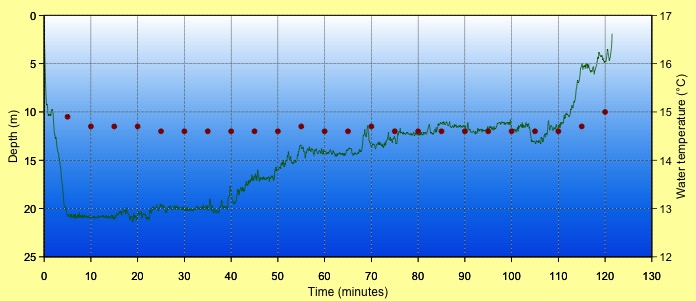
Tides at Botany Bay AEDT
Note that tides at dive site may vary from above location.
Low
4:41am
0.55m
High
11:15am
1.78m
Low
6:00pm
0.37m
High
11:56pm
1.27m
Details
I hadn't dived The Leap all that often this year with the work being done at The Steps and being sick so I was keen to perhaps get one last dive in. The conditions didn't look all that great. It was even a bit rough at The Steps for the exit. I figured I could just swim to the protected area on my safety stop and exit there.
I dived with a 12.2L tank and my 7L pony, both filled with 32%. This would give me around 2 hours and I could go relatively slowly but still have plenty of time to look for organisms.
I slid down the wall at The Leap as the tide was high and water was rough over the low platform. I swam out on the surface before descending. I swam at around 60° towards the sand line. The current was quite strong so I had to keep checking my bearing. I arrived right near the first rock in Field of Pygmies with pygmies on it. The visibility was around 10 metres and the water temperature less than 15°C. The current was quite strong and there was quite a bit of surge.
I looked on the first rock for the male pygmy pipehorse I have seen there on the last few dives. I had to search for some time before I found him (IL2019121401). I looked around for the female, who I only saw the one time, but could not find her.
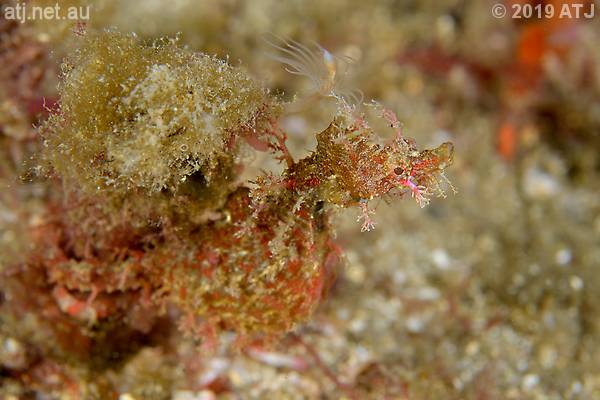
Male Sydney Pygmy Pipehorse, Idiotropiscis lumnitzeri, (IL2019121401). 20.8m.

Male Sydney Pygmy Pipehorse, Idiotropiscis lumnitzeri, (IL2019121401). 20.9m.
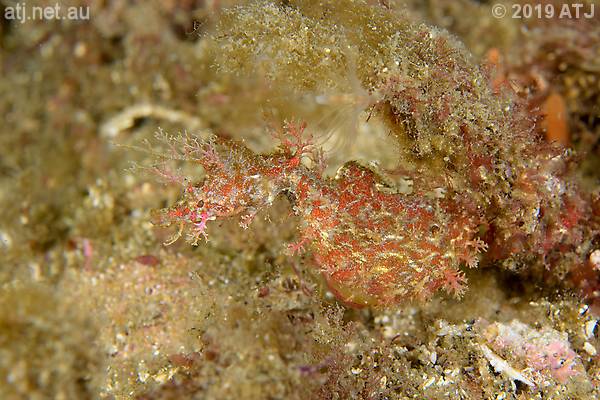
Male Sydney Pygmy Pipehorse, Idiotropiscis lumnitzeri, (IL2019121401). 21m.
I started towards The Steps. I looked on a number of rocks as I went for pygmy pipehorses but found none. I know they must be here but it is a matter of finding them. I also looked for Weedy Seadragons on the sand as I went.
I swam past and checked Bob and Lucy Rock, Ian's Pygmy Rock and the two rocks just before Seahorse Rock. I spotted two Reaper Cuttlefish on one of the rocks just before Seahorse Rock.
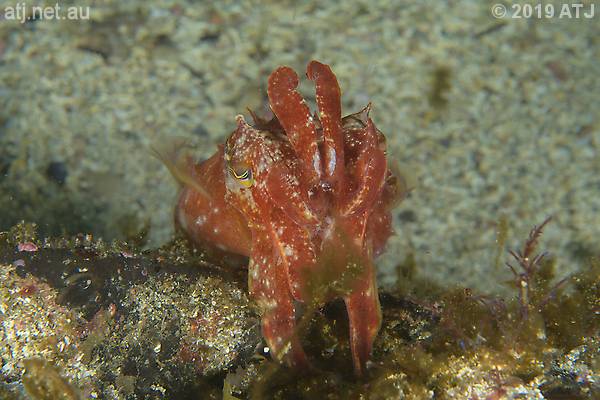
Reaper Cuttlefish, Sepia mestus. 21m.
I looked more carefully on the rock behind Seahorse Rock. I have seen a pink male there a few times and last time I found it and another red male. I looked where I'd last seen them but couldn't find them. I then looked all around the rock. I finally spotted an orange female (IL2019122901) at the other end of the rock in a spot I have not previously seen pygmies. I kept looking and found a pink male (IL2019122902) near her. At first I thought it was one of the males I'd seen last time but on checking my photographs I realised it was a different individual.
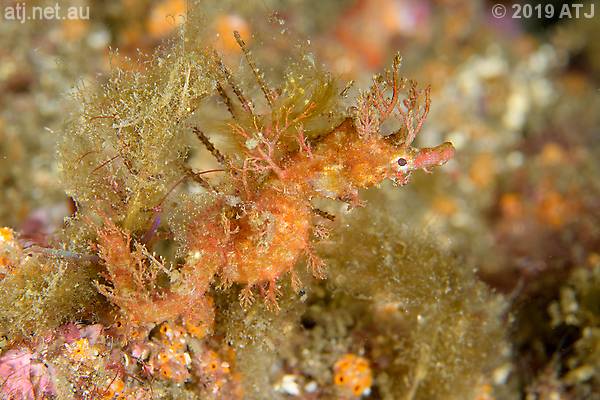
Female Sydney Pygmy Pipehorse, Idiotropiscis lumnitzeri, (IL2019122901). 20m.
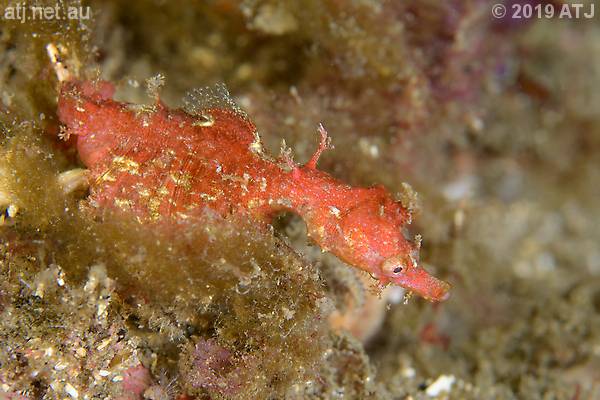
Male Sydney Pygmy Pipehorse, Idiotropiscis lumnitzeri, (IL2019122902). 20.1m.
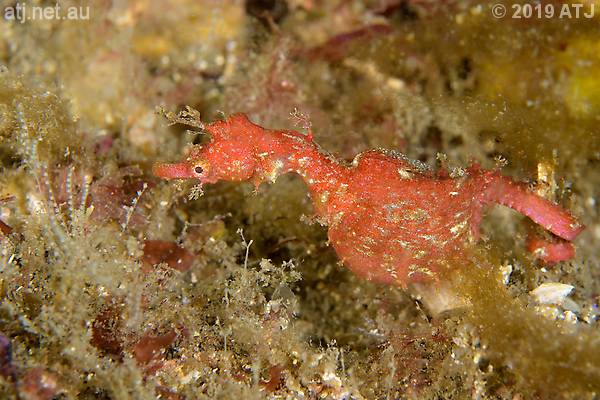
Male Sydney Pygmy Pipehorse, Idiotropiscis lumnitzeri, (IL2019122902). 20.1m.

Female Sydney Pygmy Pipehorse, Idiotropiscis lumnitzeri, (IL2019122901). 20m.
I continued on to the overhang. I spotted "Clyde" under the overhang. His eggs were new 12 days ago and had coloured up well. Assuming 6 weeks of incubation, they should be ready around 26 January. Hopefully I will get to dive here around that time.
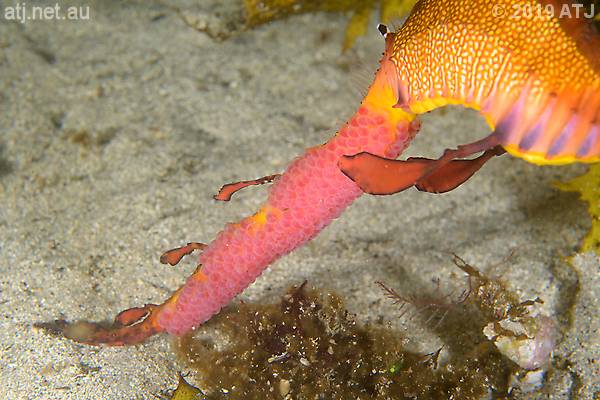
Eggs on the tail of a male Weedy seadragon, Phyllopteryx taeniolatus, ("Clyde"). 20.3m.
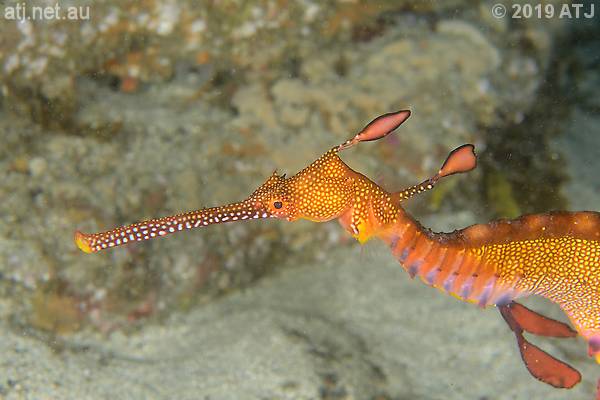
Weedy seadragon, Phyllopteryx taeniolatus, ("Clyde"). 20.4m.
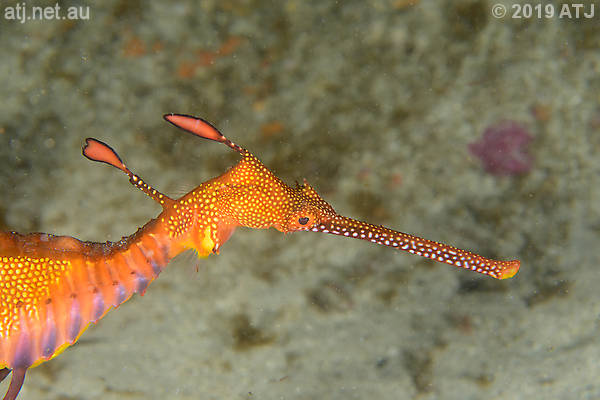
Weedy seadragon, Phyllopteryx taeniolatus, ("Clyde"). 20.3m.
I swam on to the next rock and spotted the female Weedy Seadragon. I took some photographs of her and looked for the smaller weedy that has been around but couldn't find it.

Weedy Seadragon, Phyllopteryx taeniolatus. 19.9m.
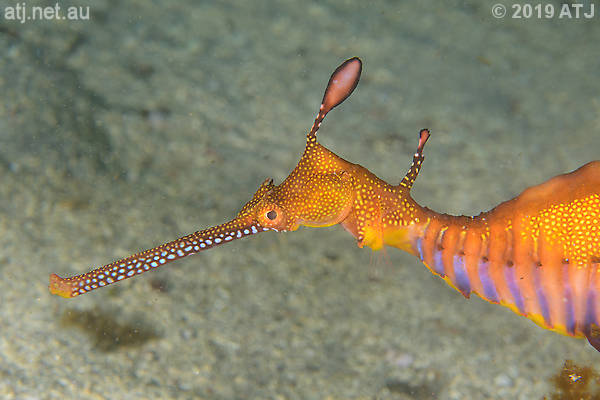
Weedy Seadragon, Phyllopteryx taeniolatus. 19.8m.
I headed along the sand line past Southern Cross Rock and into Seadragon Alley. I was hoping to find some weedies in the Alley but found none. At the end of Seadragon Alley I spotted a velvetfish. It has been ages since I have seen one.

Velvetfish, Aploactisoma milesii. 16.9m.
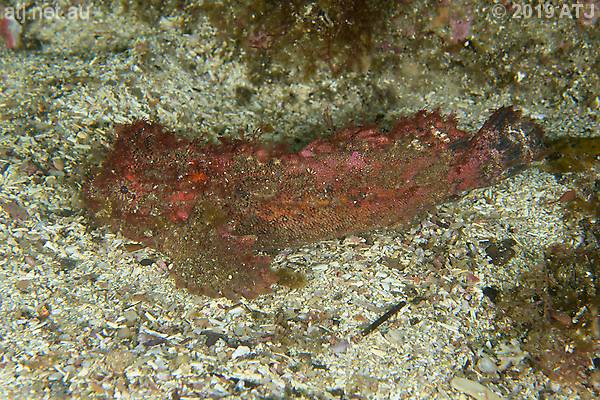
Velvetfish, Aploactisoma milesii. 16.9m.
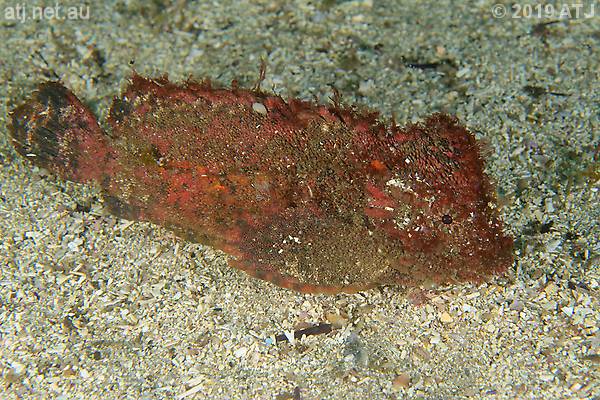
Velvetfish, Aploactisoma milesii. 16.9m.
I continued along the sand line to Big Rock. I looked for red Stigmatopora sp. pipefish as I went. At Big Rock I had a look for "Ouz", the yellow White's Seahorse but couldn't see her.
I followed the reef to the long rock. Here I spotted two male pygmy pipehorses (IL2019121401, IL2019121501) that I have seen before, a new juvenile (IL2019122903), and a new female (IL2019122904). The surge and current were quite strong here and that made photography difficult.

Male Sydney Pygmy Pipehorse, Idiotropiscis lumnitzeri, (IL2019112401). 13.8m.
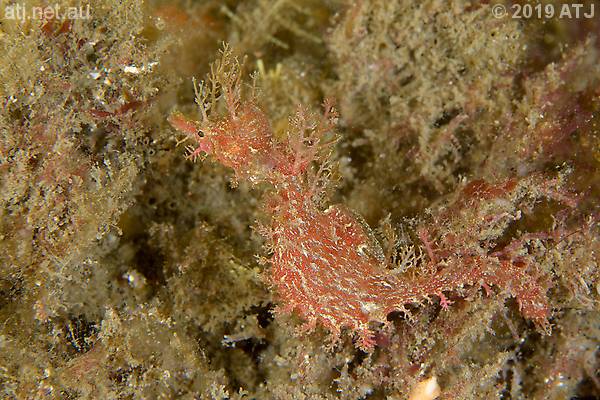
Male Sydney Pygmy Pipehorse, Idiotropiscis lumnitzeri, (IL2019121501). 14.1m.

Juvenile Sydney Pygmy Pipehorse, Idiotropiscis lumnitzeri, (IL2019122903). 14m.
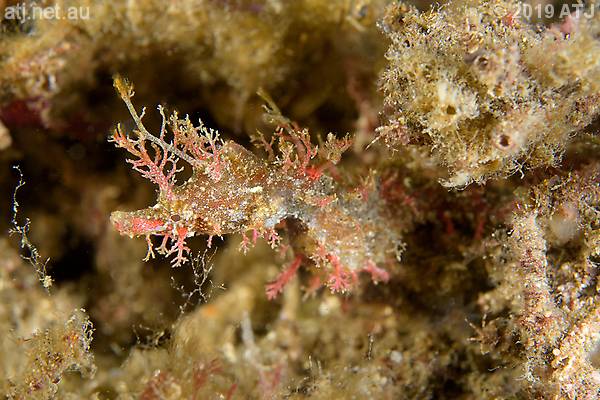
Female Sydney Pygmy Pipehorse, Idiotropiscis lumnitzeri, (IL2019122904). 13.7m.
I headed up to High Pygmy Rock to look for the Nembrotha purpureolineata nudibranchs. I was only able to find one of them. I also looked for the orange Red-fingered Anglerfish we'd seen with eggs but could not find it.
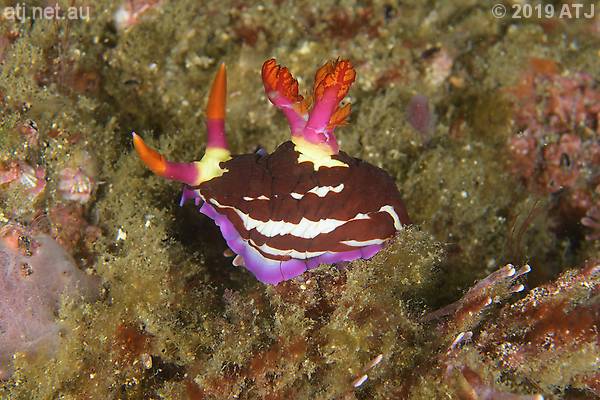
Nudibranch, Nembrotha purpureolineata. 12.5m.
I continued to the rock with the pair of pink pygmy pipehorses. I found the female (IL2019100503) on top of the rock and the male (IL2019100601) on the side where he often is.
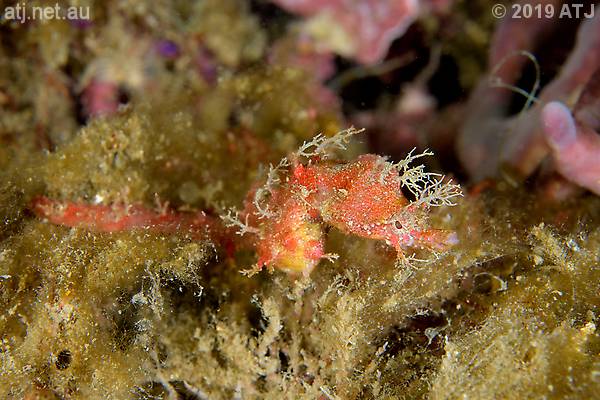
Female Sydney Pygmy Pipehorse, Idiotropiscis lumnitzeri, (IL2019100503). 13.4m.
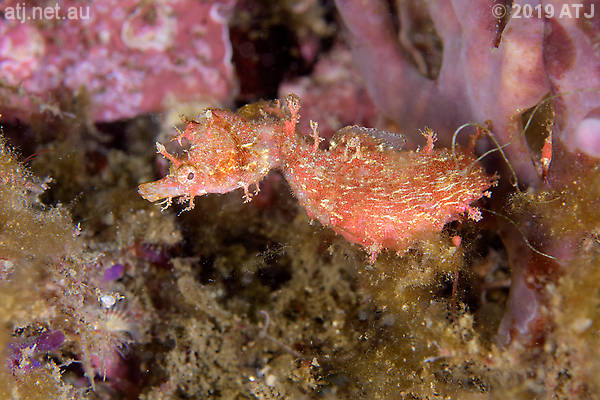
Male Sydney Pygmy Pipehorse, Idiotropiscis lumnitzeri, (IL2019100601). 13.2m.
I followed the reef to Diversity Rock and then up to the basket star. I found Cody's male pygmy pipehorse (IL2019121702) but I was not able to find the pink female. I looked around the area for the black Painted Anglerfish but the surge made it difficult.
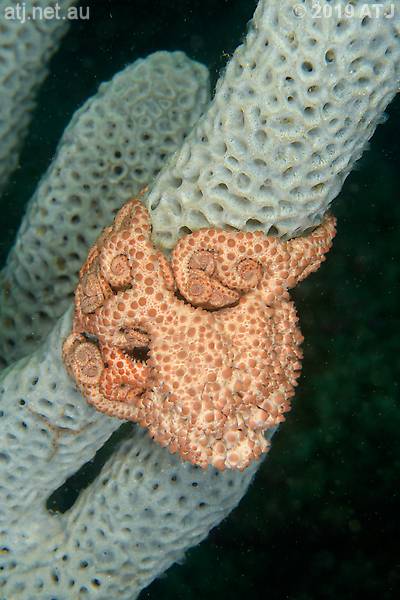
Basket star, Astrosierra amblyconus. 12m.
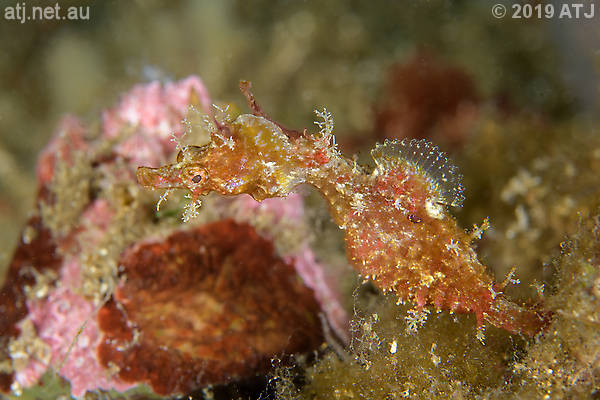
Male Sydney Pygmy Pipehorse, Idiotropiscis lumnitzeri, (IL2019121702). 12.3m.
On my way to the seahorses I looked for the orange Red-fingered Anglerfish I'd found last Sunday but could not find it. I looked for pygmy pipehorses on the rock before the seahorses and found the female (IL2019122205) I'd found last Sunday. I was not able to find any others.

Female Sydney Pygmy Pipehorse, Idiotropiscis lumnitzeri, (IL2019122205). 11.5m.
I found all three of the seahorses. "David" was on the grey sponge on the lower rock. "Skye" was on a white honeycomb sponge below the main rock. "George" was on some kelp under the main rock but swam up to the main rock. The surge was kicking up the sand making photography difficult.
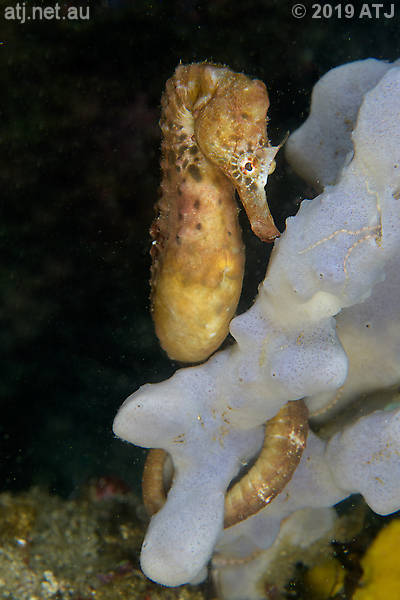
Male Pot-bellied Seahorse, Hippocampus abdominalis, ("David"). 12.2m.
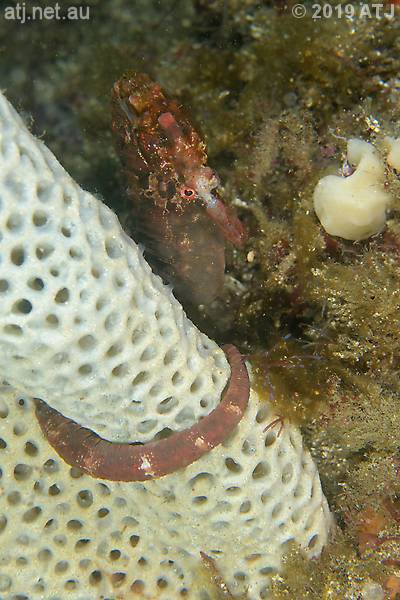
Female Pot-Bellied Seahorse, Hippocampus abdominalis, ("Skye"). 11.9m.
I headed over to the rock with the large green sponge. I spotted the female pygmy (IL2019122202) and then the male (IL2019122201). I then went back to the seahorse to get some more photographs after the sand had settled somewhat.

Female Sydney Pygmy Pipehorse, Idiotropiscis lumnitzeri, (IL2019122202). 11.3m.
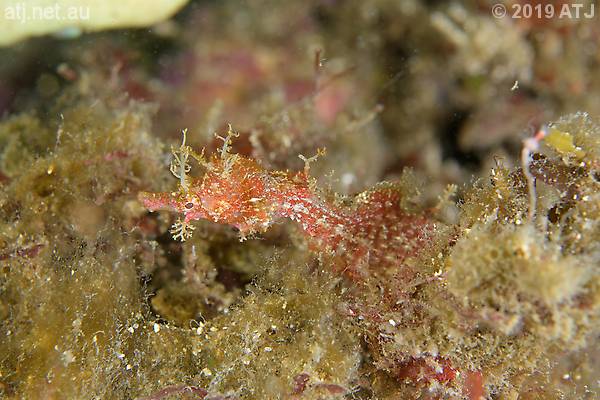
Male Sydney Pygmy Pipehorse, Idiotropiscis lumnitzeri, (IL2019122201). 11.1m.

Male Pot-bellied Seahorse, Hippocampus abdominalis, ("George"). 11.9m.
I swam along the top of the reef to the grey Red-fingered Anglerfish that Mike says has eggs. It was in the same spot but I was not able to see the eggs.

Red-fingered Anglerfish, Porophryne erythrodactylus. 11.5m.
I continued to Di's Rock before dropping down to Pipefishes Hole. I looked in the hole but could not see any pipefishes. "Teardrop", the male Weedy Seadragon was nearby. He had eggs and they were relatively new. He hadn't had eggs on Thursday. This is at least his third brood for the year. I was out of the water from late July to mid September and it is possible he had another brood in that time.

Weedy seadragon, Phyllopteryx taeniolatus, ("Teardrop"). 13.1m.

Eggs on the tail of a male Weedy seadragon, Phyllopteryx taeniolatus, ("Teardrop"). 13m.

Weedy seadragon, Phyllopteryx taeniolatus, ("Teardrop"). 13m.
I followed the sand line to the rocks where the Pot-bellied Seahorses had been late last year. I looked for the large orange Red-fingered Anglerfish but could not find it.
I headed to the rocks in front of the exit. I looked around for the orange Red-fingered Anglerfish I have seen there and spotted it on the side of one of the rocks.

Red-fingered Anglerfish, Porophryne erythrodactylus. 10.4m.
I ascended to 5 metres and started my safety stop. I had decided that if I had seen any divers near The Steps I would attempt exiting at The Steps. I hadn't seen another diver so I headed to the protected area while doing my safety stop. I found the right spot, finished my safety stop and popped up onto the platform. There were small waves coming in but it was not too bad. I stood up and took my right fin off. I had a lot of trouble with my left fin and while I was struggling a waved knocked me over. I fought the waves and swell for a bit and then put my right fin back on and swam out again for a rest. I watched what the swell was doing and worked out the best way to exit. I swam in again this time into a little shallower water. I got my right fin off again but my left fin was still somehow stuck. I then walked in slowly with my left fin on. It took ages but I eventually waded out. I had to put my camera down before I finally managed to get my fin off. I have no idea why it was stuck. I walked along the rocks to The Steps and then up to the car park.
Camera gear
Camera
Nikon D500
Lens
Nikon AF-S Micro Nikkor 60mm f/2.8G ED
Housing
Ikelite 6812.5
Lens port
Ikelite Flat Port 5502.41
Strobe(s)
2 x Ikelite SubStrobe DS161